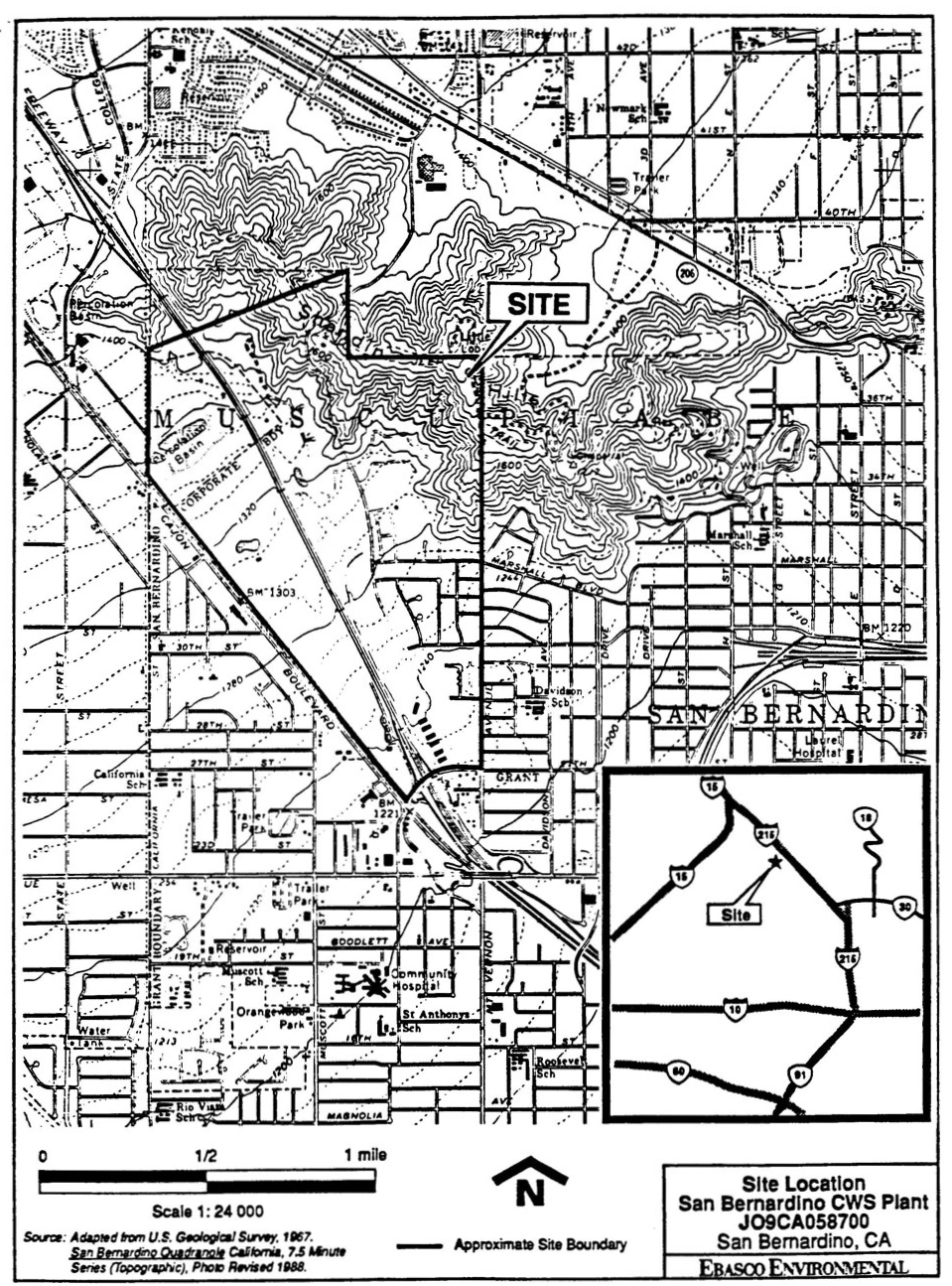The CWS contracted operation of the CWS Plant, (also -referred to as the San Bernardino Loading Plant), to Western Stove Company. Operations of the facility were to produce bombs and grenades. The existence of structures on the site prior to CWS involvement is unknown. Some time in 1944 operation of the plant was transferred to another contractor, Day & Night Flare Corporation. At that time, machinery and equipment was installed for loading bombs, and equipment was added to convert an M69 bomb line to an M69X line, financed by the government.
However, it cannot be determined whether buildings were constructed to accommodate this machinery and equipment, or if existing structures were used.
Records obtained from the U.S. Army Corps of Engineers, Office of History indicate that disposal of the site was accomplished through the termination of two leases. One lease was terminated on 20 February 1946, accounting for 15.50 acres. The second lease was terminated on 15 August 1946, accounting for 593.58 acres. Termination of these two leases accounted for the entire 609.08 acre site. A letter from 21 October 1948 to the Chief, Real Estate Division, U.S. Army indicates that a "cash settlement plus transfer of certain Government improvements was effected in lieu of the Government's performance of restoration required by the lease." Currently, the site area is partially in vacant land, and areas developed for residential, industrial, and commercial uses.
Location: The former site was located at 3196 Mt. Vernon Avenue, San Bernardino, California. The 609.08 acre triangular-shaped site area is generally bound by Cajon Boulevard to the west and south, Mt. Vernon Avenue to the east, and a line approximately along Ogden Street (south of Culligan Water Co.) to the north.
Site History: A previously prepared history dated 20 May 1991, for this site indicates that the U.S. acquired, at no cost, 593.58 acres through lease agreements, between January and March of
'1942. The San Francisco Chemical Warfare Procurement District contracted the Western Stove Company to operate the site, known at the time as the San Bernardino Loading Plant. The previous report also suggests that in January 1942 the government began construction on the bomb manufacturing plant which consisted of eight principal buildings, roads, and other facilities.
Manufacturing activities reportedly began as early as 9 March 1942. By 27 September 1942, the INPR document indicates that at least 400 employees worked at the loading plant. In late 1943, the contract with Western Stove Company was apparently terminated, reportedly due to Western Stove Company's inability to meet expected production levels. Subsequently, the Cay and Night Flare Company took over operation of the site in 1944. Documents are not available to verify this, but the government probably acquired an additional 15.50 acres during this period. The government also financed improvements at the plant including the conversion of an M69 bomb line to an M69X line. However, it cannot be determined whether additional buildings were constructed to accommodate this equipment or existing facilities were merely upgraded or expanded. Between January 1944 and November 1945, the Day and Night Flare Company manufactured incendiary bombs, reworked bomb clusters and loaded bomb fuses and bombs. Manufacturing activities probably ended in late 1945. The lease for 15.50 acres was terminated on 20 February 1946. The lease for 593.58 acres was terminated on 15 August 1946. The structures and facilities on the site were removed by late 1946. No incidents have been reported since the
Warfare Procurement District ended its accountability in 1947.
The eastern portion of the site, located to the east of Interstate 215, consists of residential and commercial properties which are privately owned. The western area of the site is occupied by the Shandin Hills Golf Club; a fenced vacant area is located along Cajon Boulevard, near the intersection withCalifornia Street; and, a partially paved area which lies between the fenced area and a Culligan Water Co. property located to the north of the site. This area contains a number of adjacent concrete pads and the remains of three steel buildings which may be attributable to prior Army use. No evidence of contamination or underground storage tanks was observed.
The fenced area located along Cajon Boulevard is restricted. Therefore, Ebasco was unable to perform a thorough survey of this area. From outside the fences, no structures appear to be visible though the topography of the area could obscure them from view. An old electrical control panel is visible on the north side of the roadway. The electrical control panel was used to operate pumps maintained by Culligan Water Co. The property is owned by Culligan Water Co. and consists of a series of water evaporation pads.
